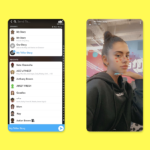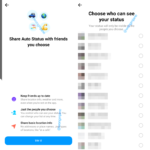Axonius nabs $58M for its cybersecurity-focused network asset management platform
As companies get to grips with a wider (and, lately, more enforced) model of remote working, a startup that provides a platform to help track and manage all the devices that are accessing networked services — an essential component of cybersecurity policy — has raised a large round of growth funding. Axonius, a New York-based company that lets organizations manage and track the range of computing-based assets that are connecting to their networks — and then plug that data into some 100 different cybersecurity tools to analyse it — has picked up a Series C of $58 million, money it will use to continue investing in its technology (its R&D offices are in Tel Aviv, Israel) and expanding its business overall.
The round is being led by prolific enterprise investor Lightspeed Venture Partners, with previous backers OpenView, Bessemer Venture Partners, YL Ventures, Vertex, and WTI also participating in the round.
Dean Sysman, CEO and Co-Founder at Axonius, said in an interview that the company is not disclosing its valuation, but for some context, the company has now raised $95 million, and PitchBook noted that in its last round, a $20 million Series B in August 2019, it had a post-money valuation of $110 million.
The company has had a huge boost in business in the last year, however — especially right now, not a surprise for a company that helps enable secure remote working, at a time when many businesses have gone remote in an effort to follow government policies encouraging social distancing to slow the spread of the coronavirus pandemic. As of this month, Axonius has seen customer growth increase 910% compared to a year ago.
Sysman said that this round had been in progress for some time ahead of the announcement being made, but the final stages of closing it were all done remotely last week, which has become something of a new normal in venture deals at the moment.
“We’ve all been staying at home for the last few weeks,” he said in an interview. “The crisis is not helping with deals. It’s making everything more complex for sure. But specifically for us there wasn’t a major difference in the process.”
Sysman said that he first thought of the idea for Axonius when at a previous organization — his experience includes several years with the Israeli Defense Forces, as well as time at a startup called Integrity Project, acquired by Mellanox — where he realised the organization itself, and all of its customers, never actually knew how many devices accessed their network, which is a crucial first step in being able to secure any network.
“Every CIO I met I would ask, do you know how many devices you have on your network? And the answer was either ‘I don’t know,’ or big range, which is just another way of saying, ‘I don’t know,’” Sysman said. “It’s not because they’re not doing their jobs but because it’s just a tough problem.”
Part of the reason, he added, is because IP addresses are not precise enough, and de-duplicating and correlating numbers is a gargantuan task, especially in the current climate of people using not just a multitude of work-provided devices, but a number of their own.
That was what prompted Sysman and his cofounders Ofri Shur and Avidor Bartov to build the algorithms that formed the basis of what Axonius is today. It’s not based on behavioural data as some cybersecurity systems are, but something that Sysman describes as “a deterministic algorithm that knows and builds a unique set of identifiers that can be based on anything, including timestamp, or cloud information. We try to use every piece of data we can.”
The resulting information becomes a very valuable asset in itself that can then be used across a number of other pieces of security software to search for inconsistencies in use (bringing in the behavioural aspect of cybersecurity) or other indicators of malicious activity — specifically following the company’s motto, “Know Your Assets, Identify Gaps, and Automate Security Policy Enforcement” — even as data itself may seem a little pedestrian on its own.
“We like to call ourselves the Toyota Camry of cybersecurity,” Sysman said. “It’s nothing exotic in a world of cutting-edge AI and advanced tech. However it’s a fundamental thing that people are struggling with, and it is what everyone needs. Just like the Camry.”
For now, Axonius is following the route of providing a platform that can interconnect with a number of other security products — currently numbering around 100 — rather than building those tools itself, or acquiring them to bring them in house. That could be one option for how potentially it might evolve over time, however.
For now, the idea of being agnostic to those specific tools and providing a platform just to identify and manage assets is a formula that has already seen a lot of traction with customers — which include companies like Schneider Electric, the New York Times, and Landmark Medical, among others — as well as investors.
“Any enterprise CISO’s top priority, with unwavering consistency, is asset discovery and management. You can’t protect a device if you don’t know it exists.” said Arsham Menarzadeh, general partner at Lightspeed Venture Partners, in a statement. “Axonius integrates into any security and management product to show customers their full asset landscape and automate policy enforcement. Their integrated approach and remediation capabilities position them to become the operating system and single source of truth for security and IT teams. We’re excited to play a part in helping them scale.”
Powered by WPeMatico
DataStax launches Kubernetes operator for open source Cassandra database
Today, DataStax, the commercial company behind the open source Apache Cassandra project, announced an open source Kubernetes operator developed by the company to run a cloud native version of the database.
When Sam Ramji, chief strategy officer at DataStax, came over from Google last year, the first thing he did was take the pulse of customers, partners and community members around Kubernetes and Cassandra, and they found there was surprisingly limited support.
While some companies had built Kubernetes support themselves, DataStax lacked one to call its own. Given that Kubernetes was born inside Google, and the company has widely embraced the notion of containerization in general, Ramji wanted there to be an operator specifically designed by the company to give customers a general starting point with Kubernetes.
“What’s special about the Kube operator that we’re offering to the community as an option — one of many — is that we have done the work to generalize the operator to Cassandra wherever it might be implemented,” Ramji told TechCrunch.
Ramji says that most companies that have created their own Kubernetes operators tend to specialize for their own particular requirements, which is fine, but as the company built on top of Cassandra, they wanted to come up with a general version that could appeal broader range of use cases.
In Kubernetes, the operator is how the DevOps team packages, manages and deploys an application, giving it the instructions it needs to run correctly. DataStax has created this operator specifically to run Cassandra with a broad set of assumptions.
Cassandra is a powerful database because it stays running when many others fall down. As such it is used by companies as varied as Apple, eBay and Netflix to run their key services. This new Kubernetes implementation will enable anyone who wishes to run Cassandra as a containerized application, helping push it into a modern development realm.
The company also announced a free help service for engineers trying to cope with increased usage on their databases due to COVID-19. They are calling the program, “Keep calm and Cassandra on.” The engineers charged with keeping systems like Cassandra running are called Site Reliability Engineers or SREs.
“The new service is completely free SRE-to-SRE support calls. So our SREs are taking calls from Apache Cassandra users anywhere in the world, no matter what version they’re using if they’re trying to figure out how to keep it up to stand up to the increased demand,” Ramji explained.
DataStax was founded in 2010 and has raised over $190 million, according to PitchBook data.
Powered by WPeMatico
Family-friendly Spotify Kids app launches in the U.S., Canada and France
Last fall, Spotify debuted a standalone Kids application, aimed at bringing kid-friendly music and stories to Spotify Premium Family subscribers, initially in Ireland. Today, that app is being made available broadly in the U.S. Canada and France, the company announced on Tuesday. The Kids app is still considered a “beta” as it arrives in these new markets, Spotify says. However, it’s been expanded with more songs, stories and other content since the original beta tests began.
The app is largely designed to boost sign-ups for Spotify’s top-tier subscription, the $14.99 (USD) per month Premium Family plan. This plan offers up to 6 people in the same household access to Spotify’s on-demand, ad-free music streaming service, each with their own personalized account. It also includes other exclusive features like Family Mixes, as well as parental controls, and now, the Spotify Kids application.
Spotify has long since realized its one-size-fits-all strategy didn’t work for families. It needed to build a unique experience separate from its flagship app in order to best cater to children — and to abide by the regulations around data collection and consent with regard to apps aimed at kids.
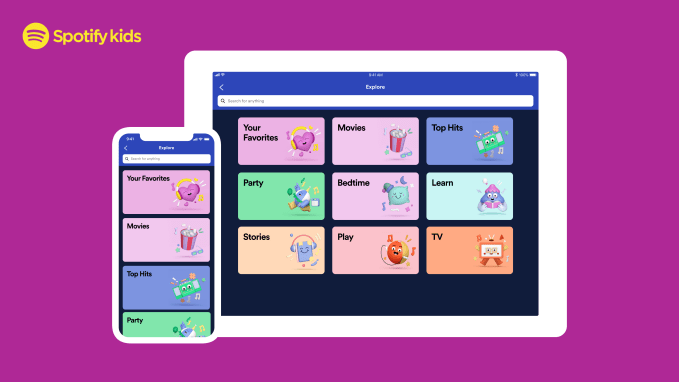
Spotify designed the Kids app from the ground up with the needs of both parents and kids in mind. For parents, it offers peace of mind that children won’t accidentally encounter inappropriate lyrics, for example, or songs with more adult themes. To ensure this remains the case, Spotify editors hand-curate the content on the Kids app by following a set of guidelines about what’s inappropriate for children. It doesn’t utilize algorithms to make selections about what’s included, the way the spinoff app YouTube Kids does.
Instead of being a fully on-demand product, Spotify Kids offers playlists for little ones focused around categories like Movies, TV, Stories, or various activities, like “Learn” or “Party,” among others. As kids grow older, they may also want to follow their favorite artists in the app.
The app can also be customized by age range. For younger kids, there’s character-based artwork and content aimed at the preschool set like singalongs or lullabies. Older kids will see a more detailed experience and have access to more popular tracks that are also age-appropriate.

The programmed playlists in Spotify Kids are curated by editors hailing from some of the most well-known brands in kids’ entertainment — including Nickelodeon, Disney, Discovery Kids, Universal Pictures, and others. They know what kids want and also what sells to the parents who pay.
Since its launch in Ireland, Spotify Kids has rolled out to Sweden, Denmark, Australia, New Zealand, the U.K., Mexico, Argentina, and Brazil.
It has also added more content since its original debut, says Spotify.
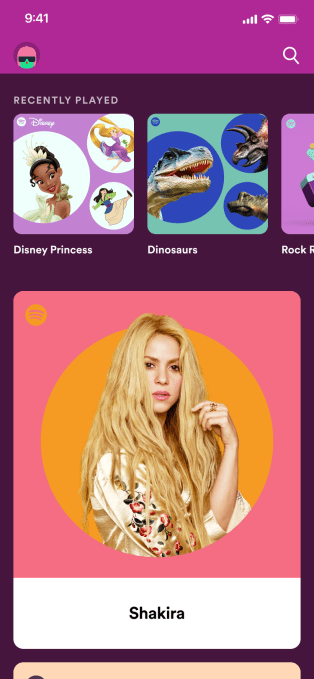
“We heard loud and clear that both parents and kids are craving more content in the app, so we’ve been increasing the number of tracks available. We’ve also heard from parents that they want even more control of the content, so we are working on some exciting new features,” noted Spotify’s Chief Premium Business Officer Alex Norström, in a statement.
The company isn’t yet going into detail about the upcoming additions, but says they’ll be focused on giving parents more control over the child’s experience. Typically, that would mean letting parents make more specific choices about what’s being streamed. But since parental controls are already available, it could mean letting parents pick specific songs or perhaps, block them. Time will tell.
Today the Spotify Kids app has over 8,000 songs in its catalog — 30% more than when it first arrived in Ireland, and growing.
It also has more local content, with 50% of the catalog in the app localized by market. Its collection of kid-friendly audiobooks and stories has grown as well, and the app now offers over 60 hours of stories, including fairy tales, classics, short stories, and stories from Disney Music Group.
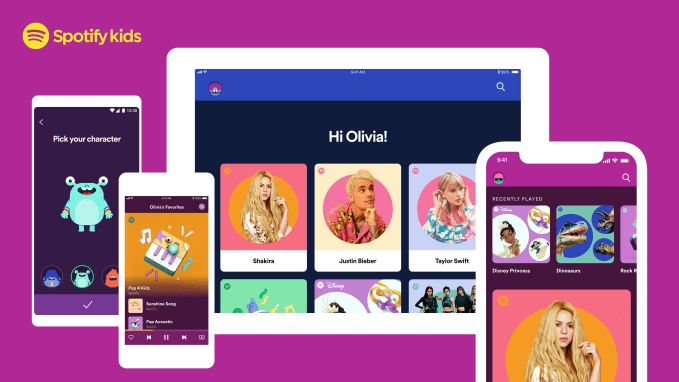
In response to user feedback, there’s also now more bedtime content like lullabies, calming music and sounds, and bedtime stories. (And yes, this finally means that Spotify parents will stop having their year-end Spotify Wrapped ruined by lullabies.)
In the U.S., Spotify Kids launches today with over 125 playlists (approximately 8,000 tracks.) In addition to mainstream kids’ music, the catalog includes Spanish-language, Country, Christian, Motown, and Soul Dance Party playlists. There’s also a Trolls World Tour playlist and another for Frozen.
In response to the COVID-19 outbreak, there’s also a new global playlist called “Wash Your Hands” which includes songs that teach kids to wash hands and to cough and sneeze properly. This includes the new song from Pinkfong “Wash Your Hands with Baby Shark.”
And to aid parents now educating children at home, there’s a “Learning” playlist hub where you’ll find songs about the ABC’s, counting, science and more.
The app is available today in the U.S., Canada, and France on iOS and Android. The app is a free download, but requires a Spotify Premium Family membership.
Powered by WPeMatico
Snapchat preempts clones, syndicates Stories to other apps
If you can’t stop them, power them. That’s the strategy behind Snapchat App Stories, which launches today to let users show off their ephemeral content in other apps too. The first partners will let you post Stories to your dating profile in Hily, share them alongside [music] videos in Triller, watch them while screensharing in Squad, or give people a peek at your life in augmented reality network Octi. Developers can now sign up to add Stories to their apps.
Snapchat’s Stories format has been widely cloned, most famously by Instagram and Facebook, but with versions in various states of development for YouTube, Twitter, LinkedIn, SoundCloud, and more. Snapchat hopes to retain some grip on Stories and dissuade more copycats by letting developers bake the original version into their apps rather than building a bootleg attempt from scratch.
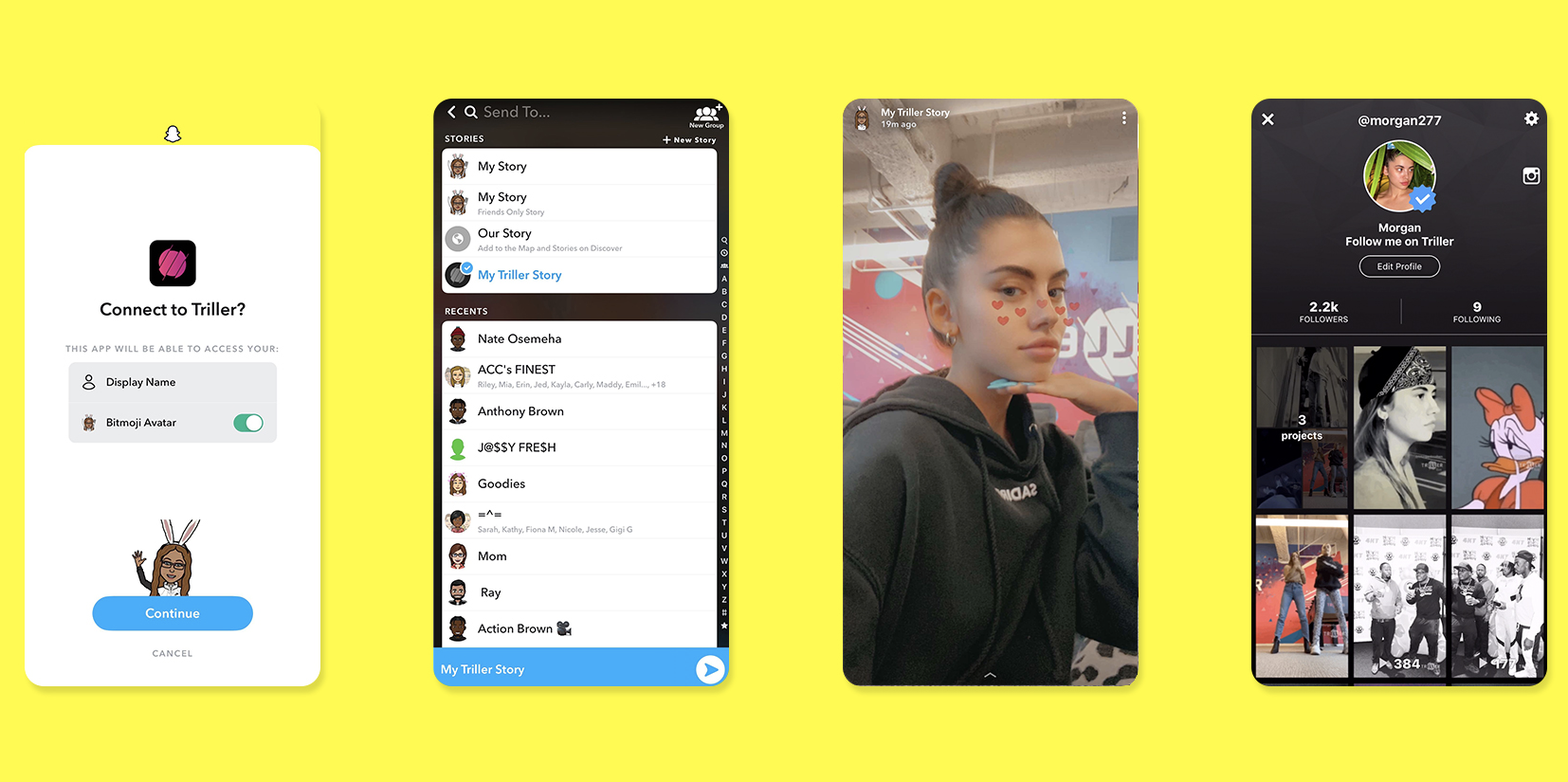
If you need Snapchat to share Stories to popular apps, that could boost content production plus subsequent viewership and ad impressions inside of Snapchat, remind people to shoot Stories, and make sure having a Snapchat account stays relevant. “We definitely think there’s a potential for monetization in App Stories but not yet” Snap’s VP of partnerships Ben Schwerin tells me. For now, Snapchat isn’t injecting ads into alongside Stories into other apps, though that’s clearly the plan.
“There are certain platforms out there that have decided they want to invest in building their own Stories product and their own camera, but it’s not a trivial thing to do. It takes resources and time. We think we can help developers do that” Schwerin explains. “Getting more people out there, regardless of age or where they live, comfortable using Stories probably makes them more likely to be able to pick up and enjoy Snapchat.”
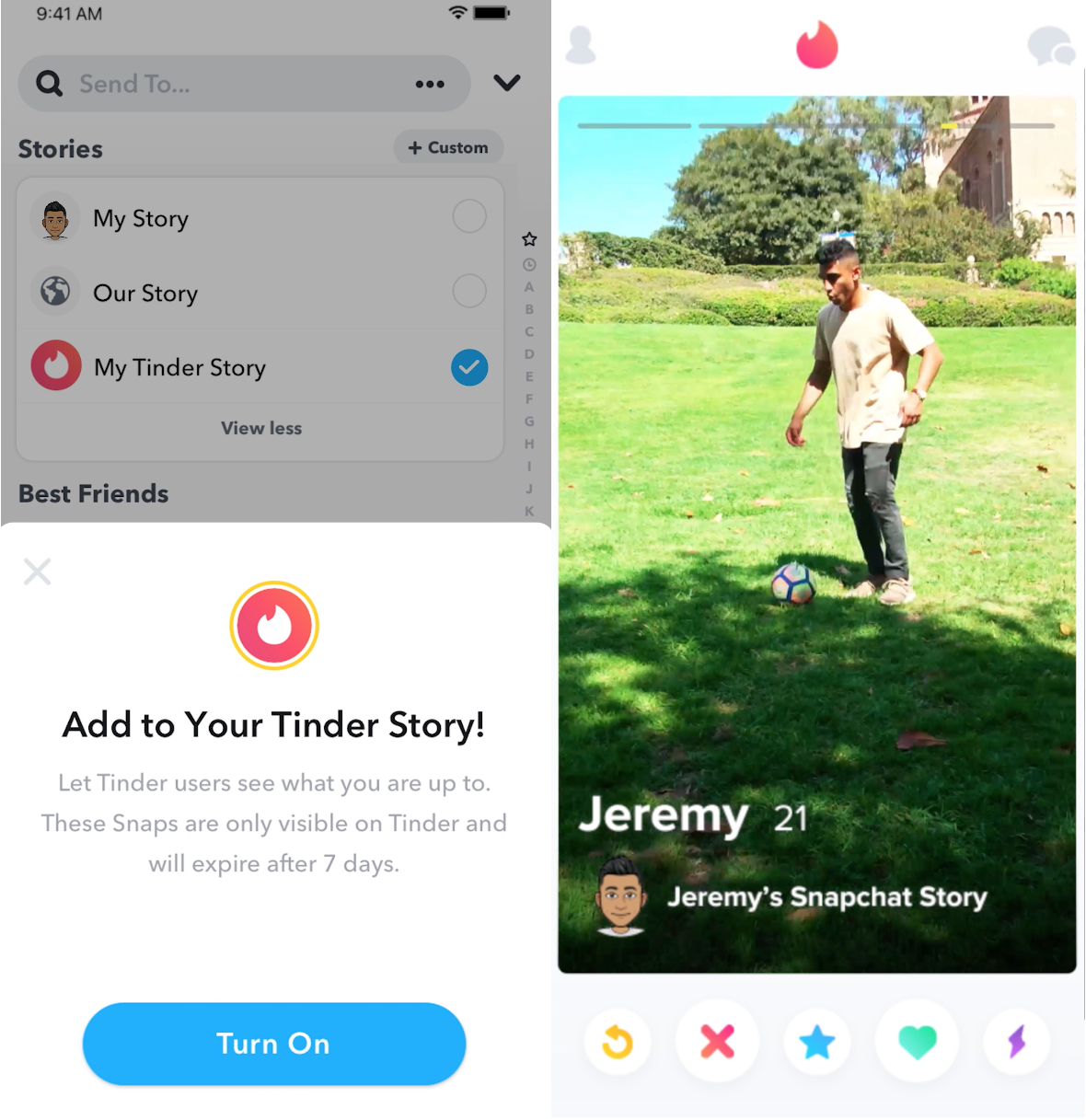
Snapchat initially announced the plan for App Stories at its Partner Summit exactly a year ago. Unfortunately, its second annual developer conference that was set for this week was cancelled due to coronavirus.
Though advertising spend may be reduced, at least the app has experienced an increase in usage while everyone shelters in place. That includes third-party apps built on its Snap Kit platform that lets developers piggyback on Snapchat’s login, Bitmoji, and camera effects.
“We continue to see incredible growth from established apps like Reddit and Spotify and TikTok, and from startups that are really building from the ground up on Snap Kit like Yolo” Schwerin reveals. “People are spending more time at home and less time with friends. We’re seeing increased usage of Snapchat.”
Snap Kit has allowed Snapchat to rally would-be copycats into a legion of allies as it fights to stave off the Facebook empire. That strategy combined with a high-performance rebuild of its Android app for the developing world led Snapchat’s share price to grow from $11.36 a year ago to a recent high of $18.98 before coronavirus dragged it almost all the way back down.
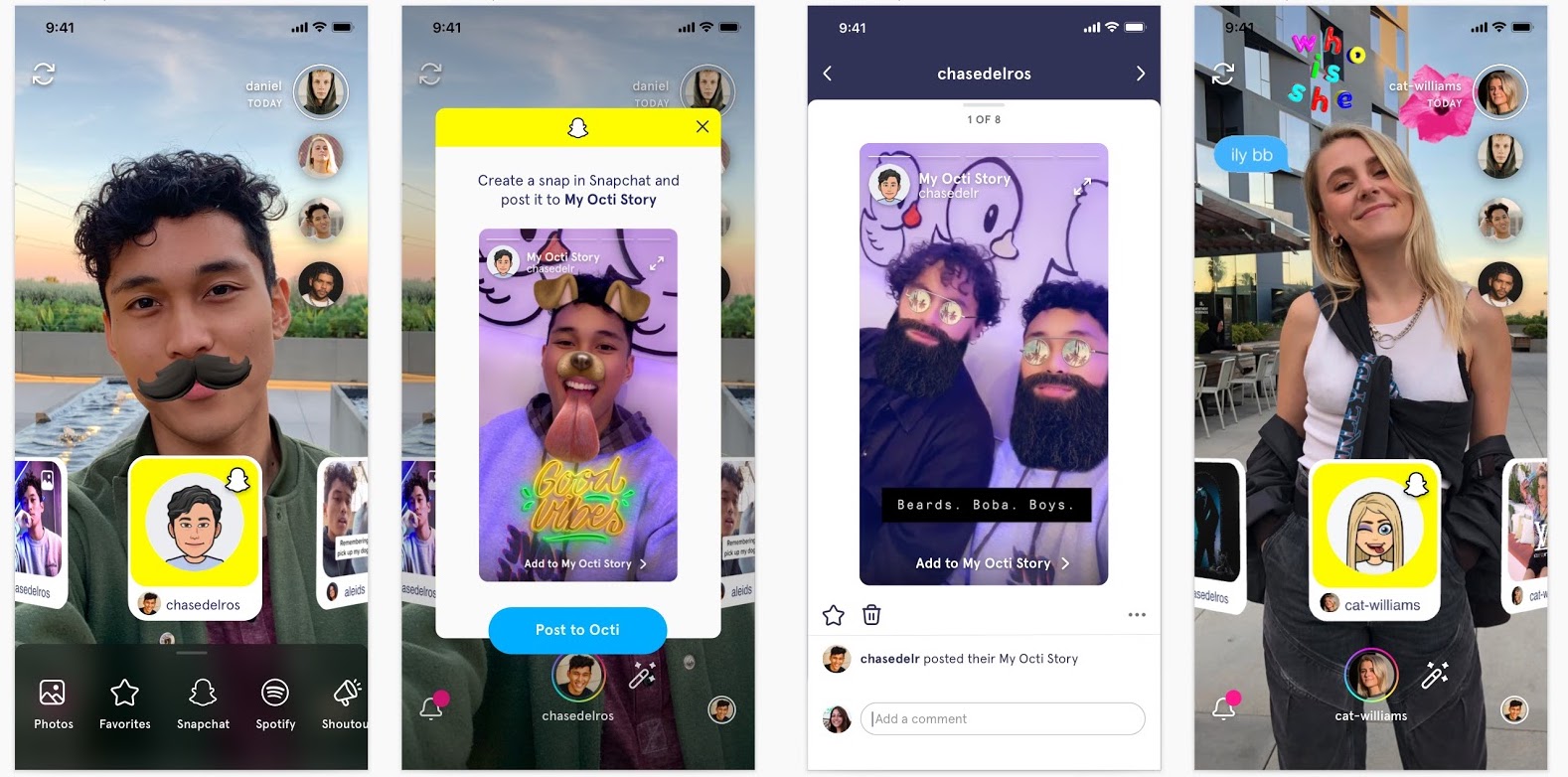
Now, when people shoot a photo or video in the Snapchat camera, they’ll get options to share it not just to their Story or Snap Map and the crowdsourced community Stories, but also to their Story within other apps integrated with Snap Kit. Users will see options to syndicate their Story to products equipped with App Stories where they’re already logged in.
Unlike on Snapchat where Stories disappear after 24 hours, they default to a 7-day expiration in other App Stories. That relieves users of having to constantly post ephemeral Snaps to keep their dating or social app profiles stocked with biographical content.
In Hily, Snapchat Stories partially replaces the homegrown version it’d spun up in the meantime to show potential dates off-the-cuff looks at people’s lives. In Triller, users can tap on a content creator’s profile pic to see biographical Stories instead of just their polished music videos. In Squad, users can co-watch Stories along with other things to screenshare. And in Octi, users can see someone’s Snapchat Story amongst other hidden content revealed by its augmented reality camera.
One app missing is Tinder, which Snapchat originally previewed as its launch partner at the App Stories reveal last year. Tinder is using Snapchat’s Bitmoji stickers, but may have gotten cold feet about Stories. The fact that Snap is only now launching App Stories, and still hasn’t officially launched Ad Kit that lets it inject its ads into other apps and split revenue with developers, shows it’s taking time to adjust to its platform strategy after years of shunning outside integrations. It still won’t reveal the revenue percentage split it’s applying to Ad Kit.
For Snapchat to gain momentum it needs two things: a constant influx of new users, eager to use its augmented reality camera and Bitmoji wherever they’re available, and more impressions to monetize with ads after Instagram stole the Stories use case for untold millions of older users. App Stories could help with both.
“The proliferation of stories as the primary way to share video content on mobile we think is a good thing” Schwerin concludes. But Snap has sat by idly as it’s served as the R&D lab for Facebook’s product. Now Snapchat needs to own the viewership and the ad dollars that Stories generate everywhere other than Facebook. Just coining the concept doesn’t bring in cash.
Powered by WPeMatico
Disney+ to launch in India on April 3
Disney said on Tuesday that it will launch its streaming service, Disney+, in India on April 3. The service, available globally in about a dozen markets, will launch in India on Hotstar, one of the most popular on-demand streaming services in the country that is also owned by Disney.
The company said it is raising the yearly subscription cost of the combined entity, Disney+Hotstar, to Rs 1,499 ($20), up from Rs 999 ($13.2) that it previously charged for its most premium content on Hotstar. TechCrunch reported last year that Disney+ will launch in India in 2020 and will increase its subscription cost.
Hotstar, which claimed to have amassed 300 million monthly active users during the cricket season in India last year, would continue to offer an ad-supported service that it will offer to users without a fee. But it is increasing the cost of both of its premium tiers.
Disney is offering a more affordable yearly tier that costs Rs 399 ($5.3) — up from Rs 365 — that will include movies from the Marvel Cinematic Universe, access to live sporting events and a wide catalog of movies and shows, and original shows produced by Hotstar. It will not include Disney+ Originals.
The $20 yearly subscription tier will offer over 100 series and 250 superhero and animated titles, including Disney+ Originals and shows from HBO, Fox, and Showtime, the company said. It will also include access to everything that Disney+Hotstar customers are availing at $5.3 tier.
All existing subscribers will be automatically upgraded to their respective new subscription plan and will be charged the new rates upon renewal, the company said.
“With the success of Hotstar, we ushered in a new era for premium video streaming in India. Today, as we unveil Disney+ Hotstar, we take yet another momentous step in staying committed to our promise of delivering high-quality impactful stories for India that have not only entertained but also made a difference in people’s lives, a promise that is even more meaningful in challenging times such as this,” said Uday Shankar, President of The Walt Disney Company APAC and Chairman, Star & Disney India, said in a statement.
“We hope the power of Disney’s storytelling, delivered through Hotstar’s technology, will help our viewers find moments of comfort, happiness and inspiration during these difficult times,” he added.
The company had originally planned to launch Disney+Hotstar in India on March 29, but it began testing the service in the country weeks prior to that.
But as the coronavirus outbreak prompted New Delhi to order a nation-wide lockdown, which put a halt to public events including the cricket tournament Indian Premier League (IPL), Disney postponed the launch of Disney+Hostar in India.
IPL cricket tournament is by far the biggest attraction on Hotstar. According to people familiar with the matter, the months following IPL saw Hotstar’s userbase drop from 300 million to about 60 million last year.
If the IPL cricket tournament, which has been postponed until mid next month, is further delayed — or cancelled — it might significantly hurt Hotstar’s relevance and financials.
If that wasn’t enough, some of the shows and movies on Hotstar may disappear soon as one of its partners, Hooq, filed for liquidation last week.
Disney was also recently criticized for blocking and censoring episodes of John Oliver’s “Last Week Tonight.” Hotstar did not stream a recent episode of Oliver’s show that was critical of India’s Prime Minister Narendra Modi and some of his policies. Hotstar has also edited out jokes from Oliver’s show that mocked Disney.
Oliver called out Disney and Hotstar for the censorship. Disney has not responded to multiple requests for comment on this matter.
Powered by WPeMatico
Despite pandemic, gaming is well-positioned to withstand recession
Efforts to slow the spread of COVID-19 have led to a global economic downturn, but the gaming industry is booming.
With hundreds of millions of people sequestered in their homes, game usage has spiked. And while the economic repercussions will persist after people cease physical distancing, gaming is positioned to fare well during a recession.
Video game usage increased 75% during peak hours
Video game usage during peak hours increased 75% in the first week many Americans began staying home, according to Verizon data. Game distribution platform Steam set a record for peak concurrent users (more than 20 million) on March 16 without any notable new releases driving demand. Gaming chat platform Discord saw its servers go down briefly last week even after the company increased capacity by more than 20% to handle surging usage.
According to Siamc Kamalie, manager of hedge fund Skycatcher, “average time spent per user on mobile games grew 41% during Chinese New Year in 2020 versus 2019, and was up 18% versus the week prior to Chinese New Year in 2020.” (Chinese New Year is when widespread stay-at-home orders began in China.)
All of the gaming industry professionals I’ve spoken to over the last week noted increased popularity of their games, though most were wary of sharing their strong performance publicly, given the unfortunate circumstances.
People don’t just turn to games for entertainment; especially when in-person interactions are restricted and most of the most popular games are multiplayer in one form or another — games also serve as social hangout spots.
Powered by WPeMatico
Local services marketplace Thumbtack lays off 250 employees
Thumbtack CEO Marco Zappacosta announced in a blog post today that the company has laid off 250 employees.
Much has been written about the impact that COVID-19 and the resulting social distancing/shelter in place measures are having on small businesses (and the steps that internet platforms like Facebook and Yelp — which, after all, make money from small businesses advertising — are taking to help).
Similarly, Zappacosta said the local services that Thumbtack showcases in its marketplace are also seeing anything from a “dramatic decline” to an “outright collapse.” Apparently the company’s business has fallen 61% in San Francisco, 55% in Detroit and 50% in New York City.
Thumbtack raised a $150 million round of funding last year, but Zappacosta said, “No business operates with enough of a buffer to sustain prolonged revenue declines of 40%+ without making radical changes.”
Those changes include reduced marketing, a hiring freeze and 25% salary reductions for executives. (Zappacosta said he will not take any salary at all, starting today.) And it also includes big layoffs.
Laid off workers will receive a severance package with both “cash and equity components,” Zappacosta said. He also said Thumbtack is doing what it can to help its service providers, such as “building features that support more remote work with customers — like video consults for a sink replacement that would typically be done onsite.”
Powered by WPeMatico
Rebecca Minkoff has some advice for e-commerce companies right now
When Rebecca Minkoff first moved to New York City, the then-18-year-old was making $4.75 an hour.
“I just kept working for this designer and someone was telling me what to do every day. I just didn’t like that. And I thought if I’m going to work as hard, it’s going to be for myself and I want to call my own shots,” she said. “I didn’t want to be told what to do, frankly.”
Self-employment for Minkoff turned out just fine; in 2001, she redesigned the iconic “I Love New York” shirt and it appeared on The Tonight Show. After a shout-out from Jay Leno, Minkoff spent the next eight months making T-shirts on the floor of her apartment and quit her job to start designing full time.
We caught up with Minkoff to learn more about how she grew her brand into a global fashion company with the help of her brother, her problem with the unicorn mentality and why she thinks the “invisible barrier” is the future of retail tech.
This interview was edited for brevity and clarity.
TechCrunch: What gave you the energy and drive to become an entrepreneur?
Rebecca Minkoff: Long story. My mom would sell these cast covers, like decorative covers for people with broken arms at the flea market. And I was like, I am going to have a booth here. So I made all these tie-dye shirts and no one bought anything but it was just this idea of like, I can make something I can sell. My mom always taught that. When I wanted a dress, she taught me how to sew a dress instead of buying the dress. And so, I just got this bug for creating things out of nothing.
The constant thread was, “I’m not going to pay for this. You’re going to learn how to do it.”
Powered by WPeMatico
Facebook Messenger preps Auto Status location type sharing
Facebook Messenger could soon automatically tell your closest friends you’re at the gym, driving or in Tokyo. Messenger has been spotted prototyping a ported version of the Instagram close friends-only Threads app’s Auto Status option that launched in October.
The unreleased Messenger feature would use your location, accelerometer and battery life to determine what you’re up to and share it with a specific subset of your friends. But instead of sharing your exact coordinates, it overlays an emoji on your Messenger profile pic to indicate that you’re at the movies, biking, at the airport or charging your phone.
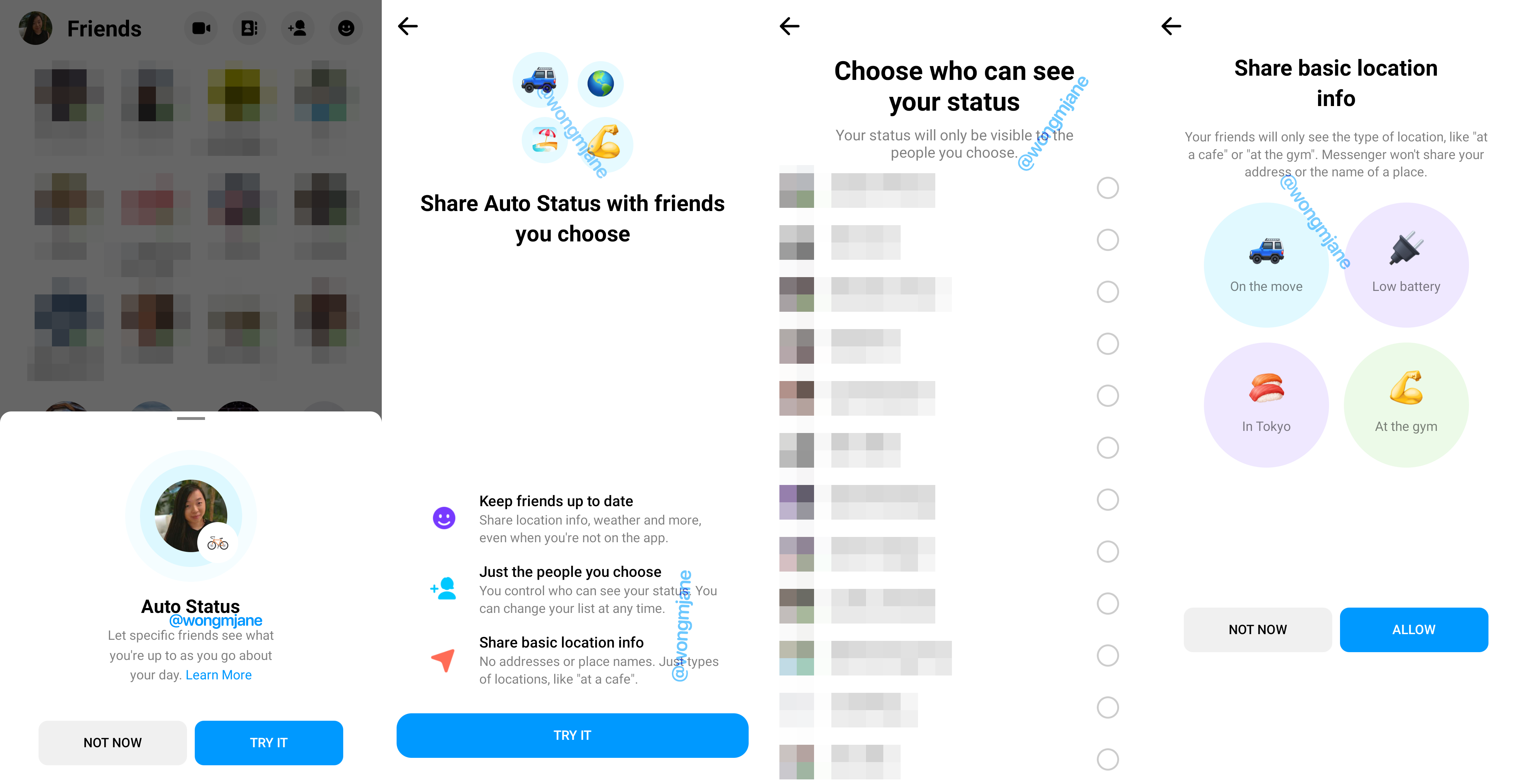
It’s unclear if or when Messenger might launch Auto Status. But if released, the feature could become Facebook’s version of the AOL Away Message, allowing people to stay in closer touch without the creepiness of exact location sharing. It might also help people coordinate online or offline meetups by revealing what friends are up to. Auto Status creates an ice breaker, so if it says a close friend is “at a cafe,” or “chilling,” you could ask to hang out.
Back in 2016, I wrote about how exact location sharing had failed to become mainstream because knowing where someone is doesn’t tell you their intention. What matters is whether they’re free to interact with you, which none of the social networks offered.
A few products, like Down To Lunch and Free, came and went in the meantime. Snapchat’s Snap Map and its acquisition of Zenly both doubled down on precise location sharing, yet still we’re often stuck home wondering if anyone we care about is similarly bored and might want to hang out.
Facebook has been experimenting in this space since at least early 2018, when its manual Emoji Status was spotted. That allowed you to append an emoji of your choosing to your Messenger profile pic. Then in October, Facebook introduced Auto Status, but only in the Instagram side-app Threads.
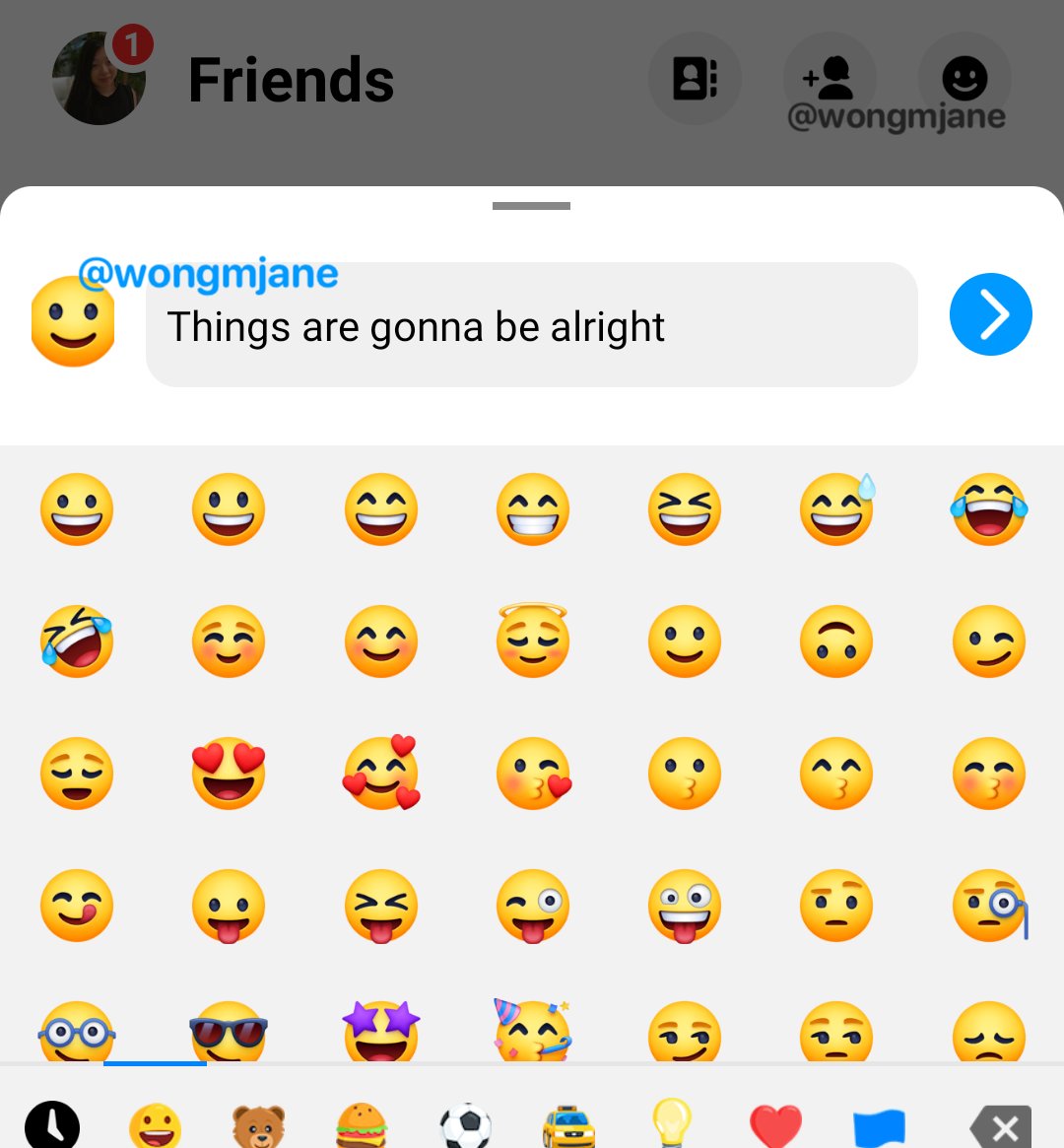
Some users were initially creeped out by the idea of Facebook relaying battery status. But Instagram director of Product Management Robby Stein explained to me that because you might not respond to a message if your phone goes dead or is left on the charger, it’s useful info to relay to friends who might be wondering what you’re doing.
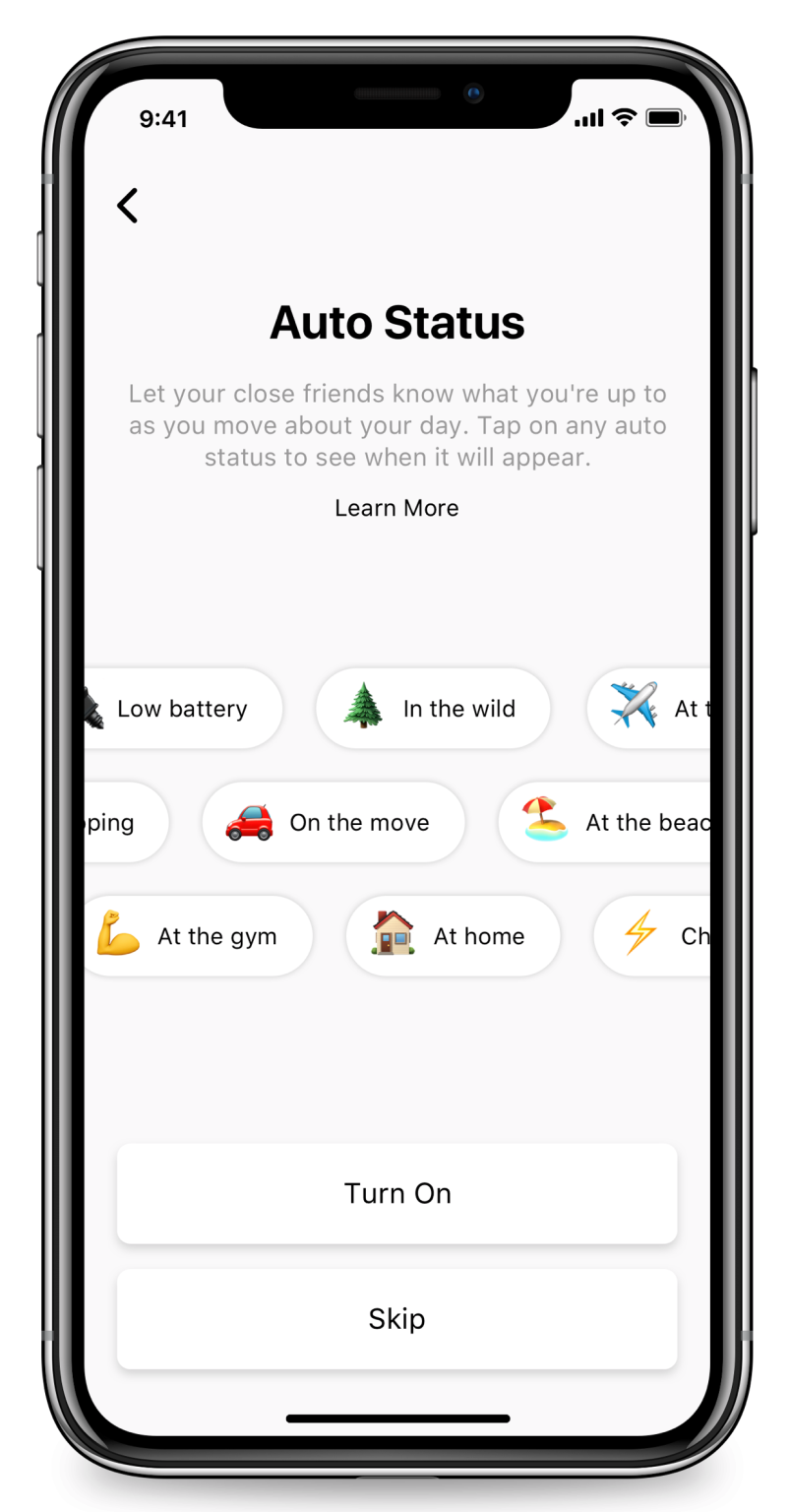 Then earlier this month, reverse engineering master and constant TechCrunch tipster Jane Manchun Wong revealed a new, unreleased version of Emoji Status hidden in Messenger’s Android code. Then today, Wong showed off how she similarly spotted Facebook trying to port Auto Status to Messenger. That would bring the feature to more than one billion monthly users compared to the relatively small base for Threads.
Then earlier this month, reverse engineering master and constant TechCrunch tipster Jane Manchun Wong revealed a new, unreleased version of Emoji Status hidden in Messenger’s Android code. Then today, Wong showed off how she similarly spotted Facebook trying to port Auto Status to Messenger. That would bring the feature to more than one billion monthly users compared to the relatively small base for Threads.
With Auto Status, you can “Let specific friends see what you’re up to as you go about your day. Share location info, weather, and more, even when you’re not in the app.” Auto Status is only visible to a special list of friends you can change at any time, similar to Instagram Close Friends. And the feature shares “no addresses or place names. Just types of locations, like “at a cafe.” Movement (driving, biking, walking), venue (at the movies, airport), cities (in Tokyo) and battery status (low battery, charging) are some of categories of what Auto Status shares.
A Facebook Messenger communications representative confirmed to TechCrunch that the Auto Status feature was being prototyped by Messenger, noting that “We’re always exploring new features to improve your Messenger experience. This feature is still in early development and not externally testing.” The company also tweeted the statement.
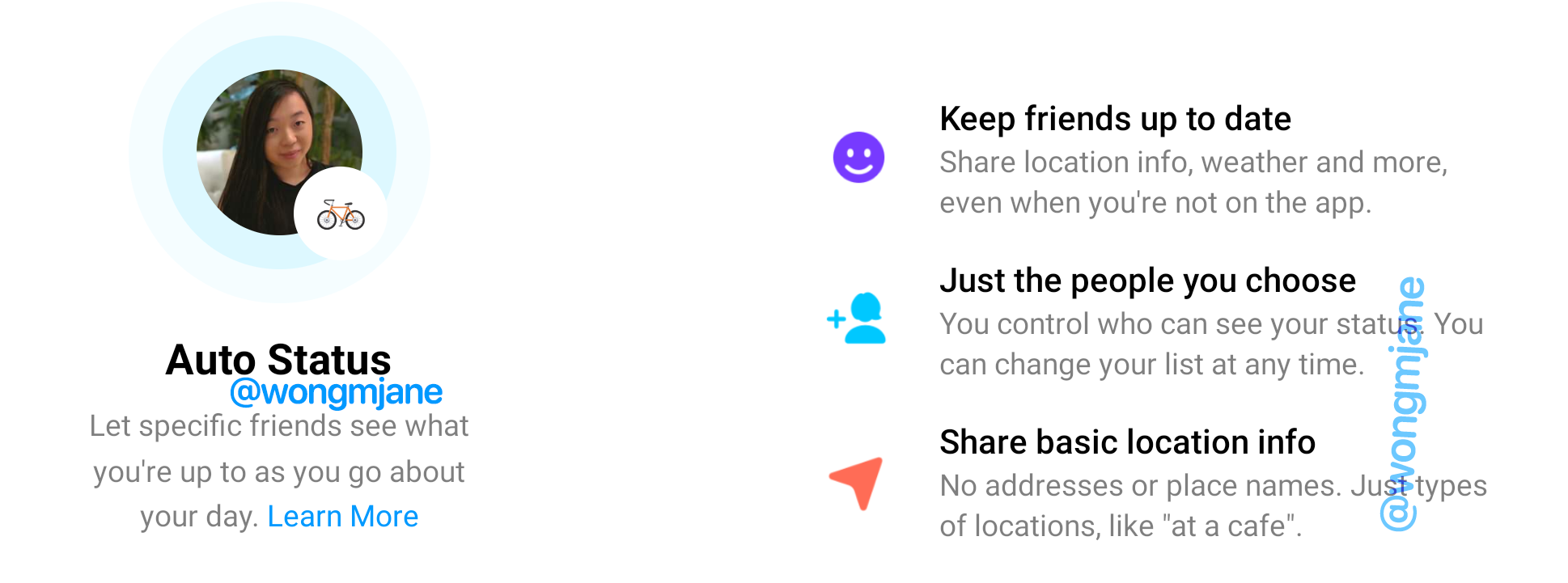
One of the biggest unsolved problems in social networking and messaging remains knowing whether friends are free to chat or hang out without having to ask them directly. Reaching out at the wrong time only to be ignored or rejected can feel awkward or intimidating, and can discourage connection later. But if you have a vague idea of what a close friend is up to, you can more deftly plan when to message them, and be more likely to get to spend time together in person or just online.
That could be a cure to the loneliness that endless feed scrolling by ourselves can leave us feeling.
Powered by WPeMatico
Niantic is updating Pokémon GO and other titles to support indoor gaming
Niantic, the development company behind popular AR mobile games Pokémon GO and Harry Potter: Wizards Unite, is adapting its titles to support at-home gaming in response to the COVID-19 pandemic. Typically, Niantic’s games have encouraged people to go outdoors, explore their world and connect with others in real life as they played. But with government lockdowns and home quarantines under way, it’s no longer safe to play these games as originally intended.
The company says it will now prioritize making changes to its AR titles to allow people to play inside and around their own homes.
For example, Niantic’s Adventure Sync function will now track your indoor steps as you do things like run on a treadmill, clean your house or make other indoor movements and activities. It’s also enhancing the games’ social features to allow friends to stay in touch virtually, and soon take on Raid Battles together while staying at home.
Instead of discouraging virtual movement inside the game, as Niantic has in the past, players will be able to virtually visit and share memories about their favorite real-world places. And this summer, Niantic will re-imagine its plans for live events to allow players to participate without having to leave home.
These updates aren’t just those made for the consideration of players’ needs during this time of crisis — they’re also necessary changes to ensure Niantic continues to operate both during the pandemic and beyond.
Niantic’s live events have driven big business to the cities that hosted them — nearly $250 million in tourism revenue in 2019, it once said. It also served as a mechanism to drive its own revenues and keep players engaged over time. The plan had worked — Pokémon GO has continued to grow, even though it’s not the hyped-up global phenomenon it was at launch. Last year was its highest-grossing year ever, a report from Sensor Tower found, as the game pulled in nearly $900 million in player spending in 2019. Much of the revenue was due to the game’s significant updates and real-world events, the report noted.
These latest updates aren’t the first changes Niantic has made in response to the COVID-19 outbreak. It had already modified gameplay in Pokémon GO to encourage users to stay inside — including by rewarding players who caught their Pokémon while inside, for example. It also just launched a new form of gameplay called the GO Battle League, which can be played from home, with reduced walking requirements and discounted select items so players wouldn’t have to walk as far to catch Pokémon, among other things.
In Harry Potter: Wizards Unite, the company increased the amount of content that’s near players on the map, so they could progress in the game without traveling far. Potions were also tuned to support people playing from home.
And in both titles, gifts were adjusted to include more helpful content throughout each day.
In Niantic’s first game, Ingress, it has made a few changes, too. Ingress Portals are now tuned to encourage at-home play and it has reduced the need to interact with multiple Portals. Several other changes make it easier to play the game without having to walk around as much.
Niantic has not yet gone so far as to fully eliminate the use of outdoor walks as a means of gameplay, however. Instead, it still encourages people to get outside — in areas where it’s permitted by local authorities to go for walks.
Though Niantic had made earlier changes to its games due to the outbreak, today’s announcement represents a more formal strategy for its business. It also lays out a detailed roadmap of what Niantic has in store. Not all its new features are live. Instead, Niantic says they’ll roll out in the “coming days and weeks,” without committing to an exact time frame.
“We created Niantic with a mission to help people get outside, exercise, and explore the world, with the ultimate goal of helping people connect with others. Today we support a global community of hundreds of millions of people who look to our games for regular entertainment and an opportunity to get outside and connect with friends,” said Niantic founder and CEO John Hanke, on the company blog.
“We have always believed that our games can include elements of indoor play that complement the outdoor, exercise and explore DNA of what we build. Now is the time for us to prioritize this work, with the key challenge of making playing indoors as exciting and innovative as our outdoor gameplay,” he added.
Powered by WPeMatico
